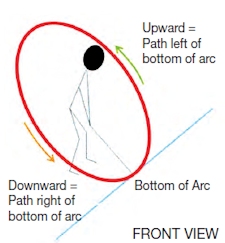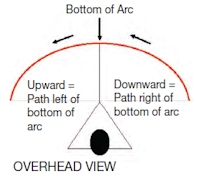Maybe The Old Guys Knew Something After All
As we progress further into the 21st century and computers and hi-tech gadgets become more prevalent, there may be a tendency to dismiss knowledge previous generations gleaned as oldfashioned or outdated. Worse, that knowledge may even be considered wrong.
 Thanks to TrackMan™ and other technologies, our knowledge of what happens at impact has become quite accurate. For years, it was taught that the clubhead path through impact determined the initial direction of the ball fl ight while the clubface angle determined where the ball fi nished. We now know that this is not accurate, and that it is the clubface angle and not the clubhead path that mainly dictates the initial direction. This information is so important that it was featured three different times in Golf Teaching Pro (Winter 2010, Summer 2011, and Summer 2013).
Thanks to TrackMan™ and other technologies, our knowledge of what happens at impact has become quite accurate. For years, it was taught that the clubhead path through impact determined the initial direction of the ball fl ight while the clubface angle determined where the ball fi nished. We now know that this is not accurate, and that it is the clubface angle and not the clubhead path that mainly dictates the initial direction. This information is so important that it was featured three different times in Golf Teaching Pro (Winter 2010, Summer 2011, and Summer 2013).
One aspect of clubhead path that has been known for years is that if the ball is too far back in the stance and the player makes a good swing, the clubhead path will tend to be to the right of where the player is aiming (for a right-handed player), and if the ball is too far forward the clubhead path will tend to be to the left of where the player is aiming. The reason, of course, is that the player is swinging on an angled plane that is not vertical. In addition to the clubhead going both down and up during the forward swing, it also goes to the right coming down and goes to the left coming up. The question is, down or up compared to what?
The answer to that is the bottom of the swing arc. These pictures give us a good idea of what this concept means:
In these pictures, we can see that the bottom of the arc is traveling down the target line and parallel with the player’s stance, and the plane of the red circle is square with the target line. A player who swings outside-in will have a swing arc that bottoms out more to the left and his plane will be angled more to the left, while a player who swings inside-out will have a swing arc that bottoms out more to the right and his plane will be angled more to the right.
As long as someone stands parallel to the target line and makes a good swing, all is well and good, right? Well, that’s what we teach, but there’s something to consider. We all know that we want to hit down with our irons and up with our driver… but assuming our plane is square to the target line in both cases, if we hit down, the clubhead path is traveling to the right, and if we hit up the clubhead path is traveling to the left!
If someone stands parallel to the target line for all clubs (as is commonly taught), how can someone hit straight shots with both a driver and the irons? The answer is that most good golfers subconsciously adjust their swings: they swing more to the left with the irons and more to the right with their driver, all without thinking about it. As their feedback is the ball fl ight, they adjust their swings until the ball goes straight with all clubs.
But, is there a better way? Perhaps. Let’s go back to those golfers from generations ago. Do you remember what the common teaching was back then? They recommended an open stance for the irons and a closed stance for the driver! The thinking back then was that since the iron swing was shorter, you didn’t have as much time to open your hips through impact, so opening your stance at address helped accomplish that. There may be some truth to that, but the better reason is much more modern, and that is the fact that if your swing direction at the bottom of the arc is parallel with your alignment and you hit down, you are actually swinging to the right! And of course, if you are swinging up on the driver, you are actually swinging to the left, so the closed stance “fixes” that, too.
 What does this mean for us as teachers, and as players ourselves? Maybe the old guys knew a little more than we thought they did. Are we saying that a square stance for all clubs is now wrong? No, we’re not saying that. But, we are saying that it might not hurt to experiment with the old school of thought, to open our stance more as the irons get shorter and close the stance a little with the driver. Some students might benefi t from this, too. Theoretically, it would mean making the same swing with all clubs without having to adjust the direction of the swing plane.
What does this mean for us as teachers, and as players ourselves? Maybe the old guys knew a little more than we thought they did. Are we saying that a square stance for all clubs is now wrong? No, we’re not saying that. But, we are saying that it might not hurt to experiment with the old school of thought, to open our stance more as the irons get shorter and close the stance a little with the driver. Some students might benefi t from this, too. Theoretically, it would mean making the same swing with all clubs without having to adjust the direction of the swing plane.
We also know that many students hit the ball somewhat straight with their irons while slicing their driver. If they’re hitting up on it, that makes sense: they’re swinging more to the left with their driver than with their irons. Closing the stance may theoretically help, but it could actually lead to a greater propensity to slice, as the target will be more to the left of where it was previously in their stance, and the swing may adjust accordingly. Instead, in this case it’s probably better to correct the swing path. Most people need to feel they are swinging more to the outside with their drivers than with their irons.
Finally, it seems the more we know today, the more the oldtimers knew what they were talking about! We can get so wrapped up in modern science that good old-fashioned common sense and things learned by trial and error can get lost by the wayside…which would be our loss as teachers and students of the game.




